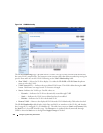
Configuring Switching Information 317
•
Role
— Displays the spanning tree role for the port in the STP topology.
•
Mode
— Displays the administrative mode and if its enabled or disabled.
•
Fast Link Operational Status
— Indicates if Fast Link is enabled or disabled for the port or LAG. If
Fast Link is enabled for a port, the port is automatically placed in the forwarding state. This setting can
be changed from the "STP Port Settings" or "STP LAG Settings" page.
•
Point to Point Operational Status
— Displays the Point-to-Point operating state.
To establish communications over a point-to-point link, the originating PPP first sends Link Control
Protocol (LCP) packets to configure and test the data link. After a link is established and optional
facilities are negotiated as needed by the LCP, the originating PPP sends
Network Control Protocols
(NCP) packets to select and configure one or more network layer protocols. When each of the chosen
network layer protocols has been configured, packets from each network layer protocol can be sent over
the link. The link remains configured for communications until explicit LCP or NCP packets close the
link, or until some external event occurs. This is the actual switch port link type.
Displaying the Rapid Spanning Tree (RSTP) Table
1.
Open the
Rapid Spanning Tree (RSTP)
page.
2.
Click
Show All
.
The
Rapid Spanning Tree Table
displays.
Figure 7-44. Rapid Spanning Tree Table
3.
Use the
Unit
drop-down menu to view the
Rapid Spanning Tree Table
for other units in the stack, if
they exist.
Defining Rapid STP Parameters Using the CLI Command
For information about the CLI commands that perform this function, see the following chapter in the
CLI Reference Guide
:
• Spanning Tree Commands


















